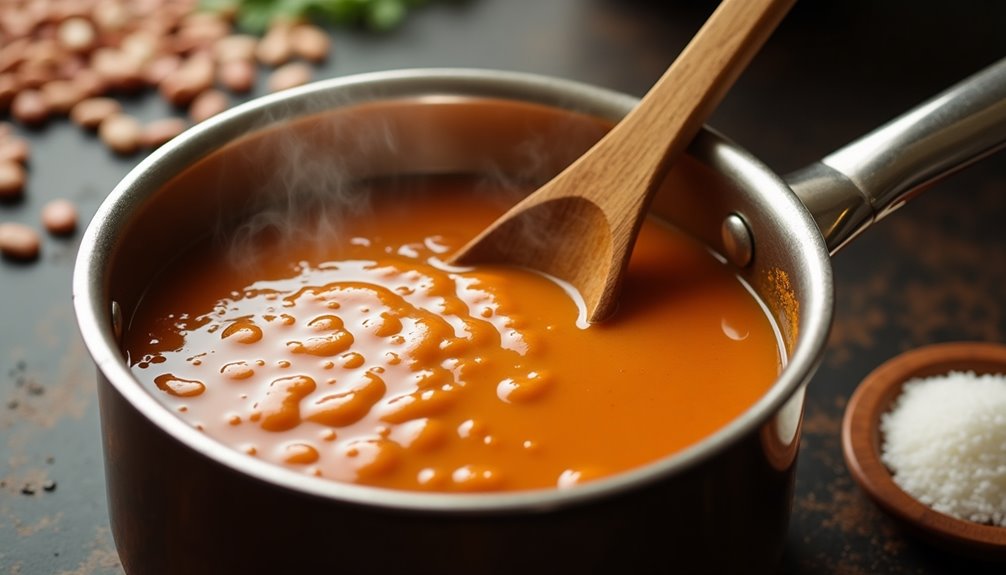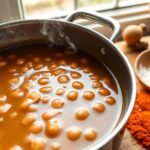To thicken bean juice, you can mash a cup or two of cooked beans and stir them back into the pot for a creamy texture. Alternatively, create a slurry by mixing 2 tablespoons of cornstarch with 1 cup of cool water and add it while stirring to avoid lumps. Simmer the beans uncovered to help moisture evaporate and intensify the flavors. Each method enhances the dish, and there's even more you can explore for variations.
Key Takeaways
- Mash 1-2 cups of cooked beans and stir them back into the pot for a creamy texture.
- Create a cornstarch slurry using 2 tablespoons of cornstarch and 1 cup of cool water, then add it to the pot.
- Simmer beans uncovered on low heat to allow moisture to evaporate and naturally thicken the liquid.
- Use bean liquid instead of water for the slurry to enhance flavor and consistency.
- Experiment with different beans or seasonings to adjust the texture and flavor to your liking.

If you've ever found yourself with bean juice that's too thin, you're not alone. Many home cooks face the dilemma of wanting a thicker, creamier consistency in their bean dishes. Thankfully, there are several simple techniques you can use to thicken bean juice and create a dish that's both delicious and satisfying.
One effective method to thicken bean juice is to remove a cup or two of the cooked beans, mash them, and then stir that mixture back into the pot. This not only helps thicken the bean juice but also adds a creamy texture that can elevate your dish. The mashed beans break down further, integrating with the liquid and creating a cohesive consistency. You'll be surprised at how such a small adjustment can transform your dish.
Another great way to achieve that thicker bean juice is by making a slurry. To do this, mix 2 tablespoons of cornstarch with 1 cup of cool water in a bowl, whisking until it's smooth. Once your slurry is ready, add it to the pot while stirring continuously. This method allows the cornstarch to thicken the liquid quickly, giving you a nice, creamy texture. Just make sure to monitor the cooking process closely; you don't want to add too much liquid at once, as it can lead to a soupy consistency.
As you thicken bean juice, adjusting liquid levels is crucial. If you find your brew's too watery, it might be beneficial to simmer the beans uncovered on low heat. This method allows moisture to evaporate, concentrating the flavors while naturally thickening the juice over time. It's a simple technique that requires patience, but the results are well worth the wait.
Consider enhancing flavor by using the bean liquid for your slurry instead of plain water. This small change can significantly boost the overall taste of your dish, ensuring a cohesive consistency that ties everything together. As the flavors meld and thicken, you'll notice how much richer and more satisfying your bean dish becomes.
Remember, cooking is all about adjusting to your preferences. If you find that the texture isn't quite right, don't hesitate to make further adjustments. You might even want to experiment with different types of beans or seasonings to see how they affect the overall flavor and consistency.
In the end, thickening bean juice is a straightforward process that can make a world of difference in your cooking. Whether you're mashing some cooked beans, creating a cornstarch slurry, or simply letting your pot simmer uncovered, these methods will ensure you achieve the creamy texture you're after.
Frequently Asked Questions
How Do You Thicken Bean Juice?
To thicken bean juice, you can start by mashing some beans and returning them to the pot. This adds creaminess and body.
Alternatively, mix cornstarch with cool water to create a slurry, then whisk it until smooth. Stir the slurry into the bean juice and cook for another 10 minutes, letting it thicken.
Keep an eye on the liquid levels to avoid a soupy consistency—adjust as necessary for your desired thickness.
How Do You Make Bean Liquor Thicker?
To make bean liquor thicker, you can start by mashing a cup or two of cooked beans and stirring them back into the pot.
Alternatively, create a slurry with cornstarch and cool water, then whisk it until smooth and mix it into the bean liquor while it cooks.
Keep an eye on it, adjusting the thickness gradually, and always taste to make sure the flavors stay balanced after thickening.
How to Thicken Bean Broth?
To thicken bean broth, you can try several effective techniques.
First, mash a cup or two of beans and stir them back into the pot.
Alternatively, create a slurry by mixing cornstarch with cool broth, whisking until smooth, then adding it to the pot.
Allow the broth to simmer on low heat, stirring occasionally.
Keep an eye on the liquid levels, making adjustments if needed to reach your desired thickness.
How to Thicken Green Bean Juice?
To thicken green bean juice, you've got a few great options.
Try mixing 2 tablespoons of cornstarch with a cup of cool water to create a smooth slurry. Alternatively, mash some cooked beans and stir them back in for a creamier texture.
You can also simmer the juice on low heat to reduce it naturally. If you prefer, adding a bit of flour or ground tapioca will help thicken it up too. Additionally, you can experiment with natural thickeners like cornstarch for a smoother consistency. Once you have the desired thickness, consider mixing in some food coloring for a vibrant twist. This is also a fun opportunity to teach kids how to create guava juice slime, turning a simple kitchen project into an engaging science experiment!
Conclusion
In your quest to thicken bean juice, remember that each method is a brushstroke on the canvas of flavor. Whether you choose to blend, simmer, or incorporate a thickening agent, you're crafting a masterpiece that dances on the palate. Embrace the journey, letting the warmth of spices and the richness of beans meld into a velvety concoction. So, roll up your sleeves and let your culinary creativity flow—your bean juice is ready to transform into a hearty delight!
Cindy thoroughly researches juicing trends, techniques, and recipes to provide readers with practical advice and inspiration. Her writing style is accessible, engaging, and designed to make complex concepts easy to understand. Cindy’s dedication to promoting the advantages of juicing shines through her work, empowering readers to make positive changes in their lives through the simple act of juicing.

















